The second vegetable seeder we’ll review in this four-part series is the Four-Row Pin Point seeder, developed in Germany by Sembdner Tools.
This seeder is the next step up from the Earthway seeder in both quality and precision. While not as versatile as some other seeders we will be looking at, it is still widely used (and even preferred) by many market farmers.
The Anatomy of the Four-Row Pinpoint Seeder
The Four-Row Pinpoint seeder is a relatively simple design made from galvanized steel with an ash wooden handle. There are very few moving parts compared to many other direct seeders. It’s comprised of four seed hoppers with brushes, a central axle/seed shaft, two wheels, and four mini-plows.
Axle & In-Row Spacing
The axle is equipped with four different hole sizes to choose from, to accommodate different seed sizes.
Hole 1:
- Diameter: 3mm
- Number of holes on shaft: 9
- In-row spacing: 1”
- Recommended crops: Arugula, Endive, Lettuce (raw), Radicchio
Hole 2:
- Diameter: 4mm
- Number of holes on shaft: 9
- In-row spacing: 1”
- Recommended crops: Carrot (raw), Green onion, Mache,
Hole 3:
- Diameter: 5mm
- Number of holes on shaft: 9
- In-row spacing: 1”
- Recommended crops: Carrot (pelleted), Lettuce (pelleted), Radish
Hole 4:
- Diameter: 6mm
- Number of holes on shaft: 7
- In-row spacing: 1 ¼”
- Recommended crops: Spinach, Beets
Wheels & Ferrules
The wheels on either side of the axle have a ferrule designed to hold the axle at your desired position. This allows you to slide the axle back and forth to select which of the four seed hole sizes will be positioned at the base of each hopper. The ferrules can be compressed with a pair of pliers to ensure a tight fit (but make sure not to over-compress them).
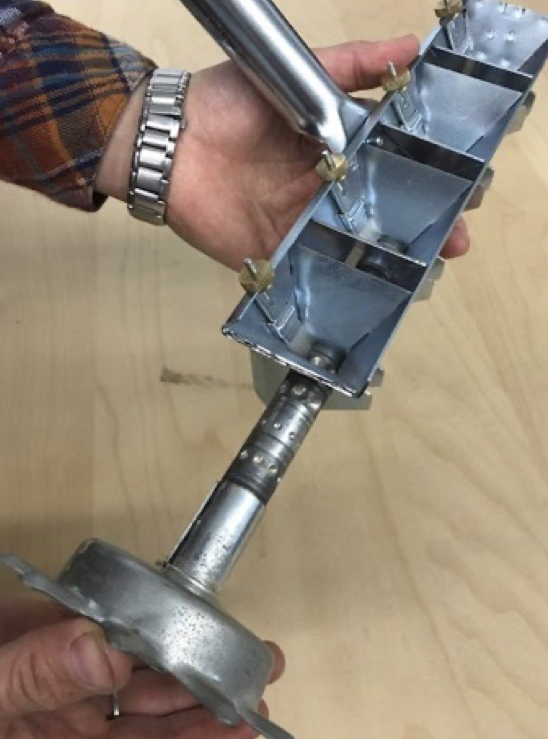
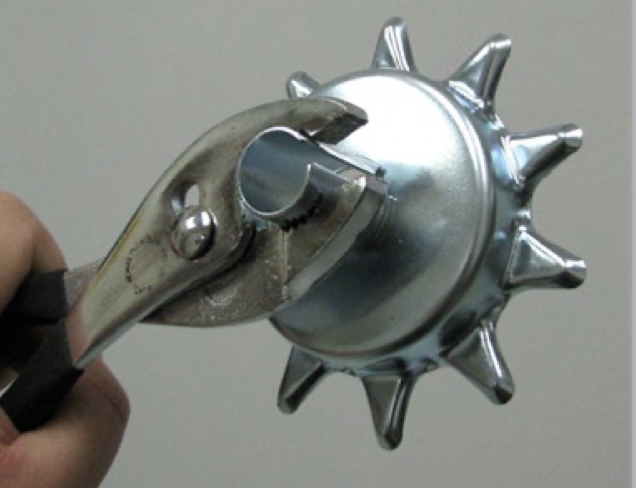
Hoppers & Brushes
There are also adjustable brushes in each hopper to brush over the seed hole as it rotates around the axle, only allowing one seed per hole to drop.
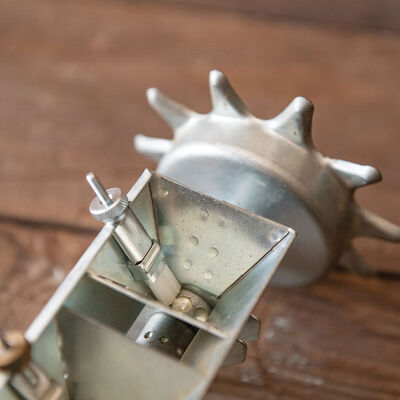
Four Mini-Plows
On the underside of the seeder body are four narrow plows to create the furrows where the seed is dropped.
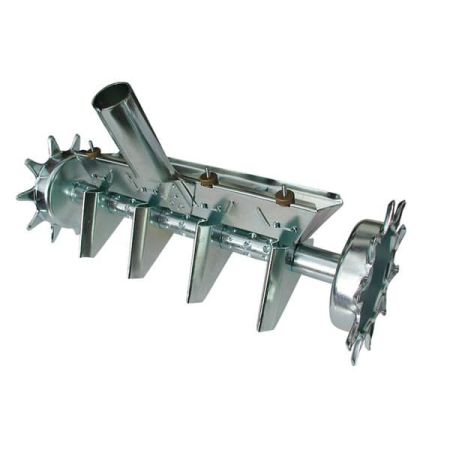
The plows are oriented for the seeder to be pulled, not pushed. The seeder allows you to plant four rows simultaneously, with each row 2 ¼ inches apart. You can also leave every other hopper empty to plant just two rows in a pass, to achieve 4 ½ inches between rows. Or you could even just fill the two outer hoppers for 6 ¾” between rows. See the image below:

How To Use the Four-Row Pinpoint Seeder
Bed Preparation
When preparing a bed for seeding with the Four-Row Pinpoint seeder, ensure that a smooth tilth is achieved in the top two inches of soil. This can be accomplished with a tilther, power harrow, or tiller. Any crop residue, small rocks, or any other debris should be raked out to not interfere with the seeding process.
The seeder will also perform best if the bed is tamped down after the soil has been prepared. This is best accomplished with a Seedbed Roller, a circular cage roller designed to tamp a bed and prepare it for ideal seeding conditions.
Seeding
Twelve evenly spaced rows can be accomplished on a standard 30” wide bed in three passes with the Four-Row Pinpoint Seeder. After the bed has been sufficiently prepared, pull a string line to mark the outer edge of the bed. On the first pass, pull the seeder to where the outer wheel is directly under the string line. On the second pass, position the wheel into the furrow created by the fourth hopper. Repeat the process on the third pass, and you will have 12 rows all spaced 2 ¼” apart.
When pulling the seeder through the bed, if you notice the wheels stop turning due to a rock, clump of compost, or some other piece of crop debris, this will immediately cue you into the fact that your seed has stopped dropping. You can then pause, remove the debris, and then reposition the seeder to where the blockage occurred and continue on from there.
Depth Adjustment
The depth of the Four-Row Pinpoint seeder can be manually adjusted by the angle at which you hold the handle. The more upright the angle, the deeper the plows will pull through the bed. The lower the angle, the more shallow the plows will pull through the bed. In general, the larger the seeds, the deeper they should be planted, and the smaller the seeds, the shallower they should be planted.
Covering the Seeds
Although there is no apparatus on this seeder for covering over the furrows after the seed is dropped, the narrow design of the plows naturally lends itself to the soil falling back in over the seeds. Irrigation after seeding will also cause the soil to naturally wash back into the furrows to cover over the seed. Another option is to roll over the bed after seeding with the Seed Roller (if you have one). This will not only fill in the furrows but also level out the bed to allow for a very close harvest of baby greens.
Pros
Low Price
The Four-Row Pinpoint seeder is currently available for about $280, a little over $100 more than the Earthway. Given its steel construction, and ability to accurately singulate seed and seed four rows simultaneously, it’s a great value.
Precise Seed Singulation
As mentioned in the previous article on the Earthway seeder, the Earthway’s primary weakness is its inability to accurately singulate seed. This is where the Four-Row Pinpoint shines! While it does have some specific requirements in regard to soil quality and level of bed prep, the Four-Row Pinpoint can do an excellent job of accurately singulating seed for densely sown crops, like baby greens and root crops.
Lightweight & Small
The Four-Row Pinpoint seeder is incredibly small and lightweight. This makes it a top choice for greenhouse growers where soil conditions are consistently good, and maneuvering in tight spaces is a must. It’s very easy to move around the farm and takes up very little space to store.
Cons
Shallow Hoppers With No Lids
One drawback of the Four-Row Pinpoint seeder is the smallness of the hoppers. Being so shallow, they only allow a low volume of seed. This requires you to keep a close eye on the seed level in each hopper as you are seeding, which can mean a lot of starting and stopping to refill hoppers, especially if you have a lot of beds to seed.
Having no lids on the hoppers is another liability. Even if you are seeding in the controlled environment of a high tunnel, one drop of condensation from the plastic can get your seeds wet. Then of course there is always the risk of spilling the seed by accidentally knocking over the seeder.
Limitations of Seed Sizes
Unlike the Earthway’s ability to also sow larger seeds, the Four-Row Pinpoint seeder is only designed to sow medium to smaller seeds, with beet-sized seeds being the largest it will accommodate. If direct sowing larger seed is a part of your crop plan, you will need to purchase another seeder to accomplish that task.
Limitation of Seed Spacing
Unlike other more expensive seeders on the market, the in-row spacing on the Four-Row Pinpoint seeder is fixed at 1” (or 1 ¼” for the largest of the four different hole sizes).
Soil Requirements
The level of bed preparation required for the Fou-Row Pinpoint seeder to operate correctly is probably its primary drawback. The soil consistency needs to be mechanically prepared to create an even, loose tilth, then carefully raked to remove any and all rocks, crop residue, remnant paper chains…and ANY other debris.
It also needs to be tamped to firm up the surface. This requires another tool, which means another step, which means another task.
The moisture level also needs to be just right: not to dry, but not too wet.
Furrows Are Not Covered
With no apparatus to cover over the furrows of freshly planted seed, it’s recommended to lightly go over the bed with the back side of a rake to cover over the rows and level out the ridges. You can also do another pass with the Seed Roller, if you have this tool.
Hacks
Custom Large Hoppers
Farmer Myles at Wise Earth Farm in Kelowna, B.C. had local metal worker custom fabricate larger hoppers to allow for starting and stopping to add more seed. He was quite pleased with the results!
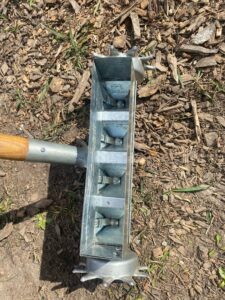
Extended Axle/Seed Shaft
There is an extended range shaft with two larger hole sizes, and two smaller, extending the range of seed sizes that the Four-Row Pinpoint seeder can accommodate.
Conclusion
In spite of its high demand for near-perfect soil conditions, the Four-Row Pinpoint seeder is still used by many market farmers. You will most often see it being put to work in greenhouses, where soil conditions are ideal, and rain and wind aren’t factors to contend with. With its small size and lightweight construction, it’s more conducive in tight spaces, especially along the edges of a greenhouse.

John Dysinger
I continue to be impressed by the quality and relevance of your posts. Keep up the good work! I will definitely be pointing people to these. I currently use the 4 row pinpoint seeder but am waiting to see if you can convince me to step up to the multi row Jang!
Seth Davis
Thanks John! I’ll do my best to convince you 😉
Rob
We would sometimes use every other hopper with ours. This would give us 4.5″ row spacing but made us have to either start from the same end every time or use a drill mark, and not a wheel mark, as our guide on the return pass. This got confusing and mistakes were made.